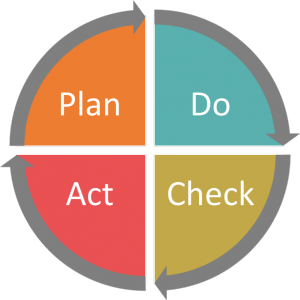How to Improve Business Performance and Productivity with the Deming Cycle
In every organisation, the need for improving business performance should be the driving force behind the action that most leaders take. Within the business world, if you are not consistently improving performance within your organisation you are stagnating. Stagnation results in other organisations bypassing you and increasing their market share. Therefore, the ability to continually improve performance should be a never-ending goal. The Deming Cycle is one of the most straight forward ways of being able to accurately plan for continual improvement. The Deming Cycle can also help increase productivity as well as improve performance in general. This is because, when organisations focus on goals that they wish to achieve, they usually begin the process by looking for possible operational improvements, thus increasing productivity as well as improving organisational performance.
The Deming Cycle was developed by W. Edwards Deming (1986) and within it he created a simple premise for predicting the results of effort to implement improvements. He put forward four logical steps that loop continually to help drive better performance.
 Plan
Plan
In the planning stage, the organisation must establish what objectives are needed to be met to create the desired goals. It is in this stage where the organisation must analyse their current position accurately to be able to correctly measure where they are, compared to where they want to be.
Do
This stage of the cycle requires the organisation begin to implement their plan and start the processes of behaviour changes. At this point, the implementation of the plan should only be carried out within a small section of the overall business. The organisation should also be collecting data to help them evaluate the process in the next steps.
Check
The ‘Check’ stage is when the data collected from the ‘Do’ stage is measured and compared against the expected goals within the ‘Plan’ stage. It is at this stage when you should be looking for any differences between what has happened and what the original goals were within the ‘Plan’ section. You should also be able to identify if there were any deviations from your plan and what was implemented, as this could account for lack of success in the ‘Do’ stage. This should lead to the understanding of whether or not the goals set in the ‘Plan’ section are attainable. If they cannot be reached, the process may need to end here and started again.
Act
Within this stage the organisation first needs to identify that all the other stages were carried out correctly, i.e. the ‘Check’ stage identified that the ‘Plan’ stage was correctly implemented within the ‘Do’ stage. Secondly, it needs to be confirmed that the outcomes have resulted in improvements on what had come before. If so, the process can then implemented throughout the whole organisation. This new and improved process would then become the required standard that the organisation must meet.
The Deming Cycle can be used and reused for almost any activity within an organisation, meaning the organisation is constantly reviewing its practices and processes and therefore continuously improving performance and productivity.



